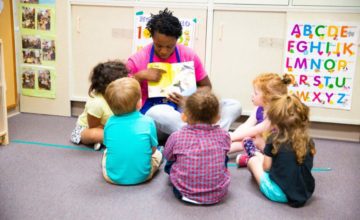Learn about the many ways that parents help their older toddlers learn to feel good about who they are and to believe in themselves and their abilities.
Two-year-olds are very capable people. They can run, jump, sing, play pretend, and solve complex problems—like how to get to the Halloween candy that Mom put up on the counter. Many also want to do more of their own self-care—like brushing their hair or getting dressed on their own. This makes them feel strong, confident, and smart—key ingredients for later school success.

Build your child’s self-esteem
Your reactions to your child send powerful messages about who he is and what his strengths and abilities are. When you give him lots of hugs and kisses, talk, sing, laugh, and dance with him, you let him know he is loved and fun to be with. These kinds of messages are the foundation of self-confidence.
Another everyday way to build your child’s sense of confidence and self-esteem is to find ways for your child to help out with family chores. Children this age love to help out with “grown-up” tasks. They feel great pride when they can show you how they feed pets or water plants. Believing they are a valued and contributing member of the family builds children’s confidence and self-worth.
What you can do:
- Delight in your child’s discoveries as she explores. This lets her know she is interesting, important, and loved.
- Give your child support in trying new things. This tells him you believe he is smart and capable.
- Be specific about what tasks you want your child to help with. Please pick up your blocks, instead of, Let’s clean up the room. Keep the task fairly small and within your child’s skills. Manage your own expectations about how the task is completed. If you ask your child to match socks, expect some mismatches. If you ask your child to put the blocks away, you may still find some “strays.” This is developmentally normal and just part of the learning process.
- Recognize and be specific about what your child accomplished: You counted out all 4 napkins and put them on the table. Good job. Now we can eat. This emphasizes to your child what an important contribution he is making. Learning to help out will also help him later when he is asked to perform many “jobs” around the classroom.
Help your child make sense of the world
As your toddler grows, your role as a parent becomes one of “translator” or “explainer” for your child. When you help her understand how the world around her works, you are helping her cope with life’s realities. This builds self-confidence.
It’s also important that you model self-confidence. Your toddler looks to you to learn how to work through challenges and resolve conflicts. When you believe in yourself, and talk with your child about your own process for overcoming challenges, you provide a powerful example of how to approach the world with confidence and optimism.
What you can do:
- Help your child understand and cope with rules. You don’t like nap time at school. But it’s a rule. Having naptime is important because children need time to rest. I know it’s hard to stay quiet for that whole time when you can’t sleep. Let’s see if we can talk with Ms. Marta about bringing in some small, quiet toys you can play with on your cot for the times you can’t sleep. These kinds of explanations help children feel safe, secure and in control—all of which builds their self-confidence and ability to cope and problem-solve.
- Help your child understand complex situations. As bright and verbal as 2-year-olds can be, there are many situations they face that can be quite confusing. Helping them understand these experiences gives them confidence that they can handle them. I know you are sad that Marco didn’t play with you at the park today. He was already playing ball with another child. But I know he still likes you and is your friend. How about if we invite him over to play this weekend?
Show your child how you think through challenges
Hmmm, putting this toy together is kind of tough. I am having a hard time. But let me look at the directions again. Can you pass me that part? Where do you think it goes? I think we can figure this out together! Share your toddler’s excitement about her accomplishments. “Watch this!” “Come see my show!” “Watch my trick!” Toddlers love having an audience—and their favorite audience is you. Being appreciated by the person who loves them most is critical for building self-confidence. Believing that “I can do it” means that children have developed a positive view of themselves and their abilities.
What you can do:
- Take the time to watch and delight in your child’s accomplishments. This shows you value her interests and builds her self-confidence as she sees herself as smart and capable (not to mention entertaining!).
- Focus on your child’s efforts and feelings about his accomplishment (versus yours). Focus on your child’s efforts. For example: You are pushing the pedals so hard to make the tricycle go! Wow, you are so strong. Look, it’s moving—little by little. This sends a very different message to your child than saying, Mommy is so proud of you! First, it lets your child know that you are proud of his efforts. He learns that he doesn’t have to succeed to be loved and valued by you. And, focusing on persistence and effort motivates children to learn new skills because it makes them feel good about themselves, not because they desire praise from others. This is called “internal motivation” and it is a powerful force in later school achievement.
Join in your child’s pretend play
In your child’s third year, you will see him engaging in pretend play more and more. These games—acting out stories, taking on roles or characters—help your child feel confident that he is fun, interesting, and has good ideas.
In addition, children act out their thoughts and feelings through the stories they create during pretend play. A toddler may pick up a purse, put on a coat, and pretend she is the mommy going off to work. This helps her cope with feelings around separation. Another toddler who has a new brother or sister may play out a story with action figures or stuffed animals where one of the characters has to go away, return to the hospital, etc. Working out their feelings in this safe way can give children confidence to handle the new—and sometimes—challenging situations they encounter as they grow.
What you can do:
- Join in your child’s pretend play. Let him be the “director.” Take on whatever role you’re assigned, whether it is a T-Rex or princess, and have fun together. This lets your child know you value his ideas and see him as a leader which builds self-confidence.
- Use pretend play to help your child work through difficult feelings and experiences. You can help your child express feelings she is struggling with when you join in her play. Take on the role of one of the characters in the story your child is creating. Make statements and ask questions about the feelings and situations your child acts out. For example, Bear seems really angry. What is he mad about? Or, I wonder if Clifford is scared to play with the other doggies. What can we do to help him?
Help your child be a good problem-solver
Support your child’s efforts to work out problems—whether it is resolving a conflict with a friend or trying to get a mitten on. But don’t jump in right away to solve it. These are chances for your child to feel successful. Guide and support him in accomplishing the task, but don’t do for him what he has the skills to accomplish himself with some effort.
Your child’s times of greatest frustration are, in fact, golden opportunities for her to develop feelings of confidence, competence, and mastery. She’ll learn that she can depend on you to encourage her, but that she can find the solution. Of course, if your child has tried and clearly can’t accomplish what she wants to do—like open a doorknob with mittens on—offer a little assistance. Provide just enough support to get her over the “hump,” and then step back again and let her take the next step toward the solution.
What you can do:
- Empathize with his frustration. You are working so hard to get your mittens on! It takes time to figure it out.
- Ask her if she knows what may be causing the problem.
- Offer your observations—for example, that he has forgotten to poke his thumb into the thumb space of the mitten.
- Ask if she has any ideas about how to get it on correctly.
- Ask if he wants suggestions—How about putting your thumb in first and then your hand?
- Provide the support she needs to be successful—for example, helping her position her fingers to get them in correctly.
Let your child know it’s smart to ask for help
It’s important for children to know that everyone needs help sometimes, and that asking for help is not a sign of weakness. Knowing when you need help and asking for it is actually a sign of strength and builds self-confidence. The help children receive from others allows them to work through new challenges. You were having a hard time using the blocks to make a staircase for your house. You asked Daddy for help and we figured out how to do it. Now you have a beautiful staircase for your little people to climb.
What you can do:
- When you see your child struggling, ask what kind of help he wants. Getting shoes on can be so hard! Sometimes opening up the laces can make it easier. Would you like me to help you loosen them?
- Let your child see that you sometimes need help, too. Ask others for help when you need it. It makes your child feel especially good when you ask her for help: Can you take one of the grocery bags in the house? Mommy’s hands are full.
What You Can Do
Delight in your child’s discoveries as he explores.
This lets him know he is interesting, important, and loved.
Give your child support in trying new things.
This tells her you believe she is smart and capable.
Help your child understand and cope with rules.
You don’t like nap time at school. But it’s a rule. Having naptime is important because children need time to rest. I know it’s hard to stay quiet for that whole time when you can’t sleep. Let’s see if we can talk with Ms. Marta about bringing in some small, quiet toys you can play with on your cot for when you can’t sleep. These kinds of explanations help children feel safe, secure, and in control—all of which builds their self-confidence and ability to cope and problem-solve.
Help your child understand complex situations.
As bright and verbal as 2-year-olds can be, there are many situations they face that can be quite confusing. Helping them understand these experiences gives them confidence that they can handle them. I know you are sad that Marco didn’t play with you at the park today. He was already playing ball with another child. But I know he still likes you and is your friend. How about if we invite him over to play this weekend?
Share how you think through challenges.
Hmmm, putting this toy together is kind of tough. I am having a hard time. But let me look at the directions again. Can you pass me that part? Where do you think it goes? I think we can figure this out together!
Take the time to watch and delight in your child’s accomplishments.
This shows you value his interests and builds his self-confidence as he sees himself as smart and capable (not to mention entertaining!).
Focus on your child’s efforts and feelings about her accomplishment (versus yours).
Focus on your child’s efforts. For example: You are pushing the pedals so hard to make the tricycle go! Wow, you are so strong. Look, it’s moving—little by little. This sends a very different message to your child than saying, Mommy is so proud of you! First, it lets your child know that you are proud of her efforts. She learns that she doesn’t have to succeed to be loved and valued by you. And, focusing on persistence and effort motivates children to learn new skills because it makes them feel good about themselves, not because they desire praise from others. This is called “internal motivation” and it is a powerful force in later school achievement.
Join in your child’s pretend play.
Let him be the “director.” Take on whatever role you’re assigned, whether it is a T-Rex or princess, and have fun together. This lets your child know you value his ideas and see him as a leader which builds self-confidence.
Use pretend play to help your child work through difficult feelings and experiences.
You can help your child express feelings she is struggling with when you join in her play. Take on the role of one of the characters in the story your child is creating. Make statements and ask questions about the feelings and situations your child acts out. For example, Bear seems really angry. What is he mad about? Or, I wonder if Clifford is scared to play with the other doggies. What can we do to help him?
Be specific about what you want your child to help with.
Please pick up your blocks, instead of, Let’s clean up the room. Keep the task fairly small and within your child’s skills. Manage your own expectations about how the task is completed. If you ask your child to match socks, expect some mismatches. If you ask your child to put the blocks away, you may still find some “strays.” This is developmentally normal and just part of the learning process.
Recognize and be specific about what your child accomplished:
“You counted out all 4 napkins and put them on the table. Good job. Now we can eat.” This emphasizes to your child what an important contribution he is making. Learning to help out will also help him later when he is asked to perform many “jobs” around the classroom.
Empathize with her frustration.
You are working so hard to get your mittens on! It takes time to figure it out.
Ask him if he knows what may be causing the problem.
Offer your observations.
For example, that she has forgotten to poke her thumb into the thumb space of the mitten.
Ask if he has any ideas about how to get it on correctly.
Ask if she wants suggestions.
How about putting your thumb in first and then your hand?
Provide the support he needs to be successful.
For example, helping him position his fingers to get them in correctly.
When you see your child struggling, ask what kind of help she wants.
Getting shoes on can be so hard! Sometimes opening up the laces can make it easier. Would you like me to help you loosen them?
Let your child see that you sometimes need help, too.
Ask others for help when you need it. It is especially good for your child when you ask him for help: Can you take one of the grocery bags in the house? Mommy’s hands are full.
Parent-Child Activities That Promote Self-Confidence
Give your child lots of chances to do “real” jobs
Preparing meals—tossing lettuce into a bowl, pouring milk into cereal, breaking eggs—offers many opportunities for your child to take on responsibility and feel successful. Your toddler can help you with chores like doing laundry and gardening. He can match socks or separate shirts from pants, or water plants in the garden outside.
Encourage friendships
Making and keeping friends nurtures a toddler’s growing self-confidence and self-esteem. Create plenty of opportunities to meet and play with children her age. Always be close by so you can help your child learn to share and work out problems that will surely come up. This will help her feel confident that she can deal with the challenges that are part of building healthy relationships as she grows.
Help your child use words to work through challenges
You tried to pour your own juice. Good for you. Some juice is in the cup. Some spilled. When that happens, you can tell Mommy and ask for help cleaning it up. Then we can do it together. Giving your child the words he needs makes it more likely that he will ask for help. It will also help him understand what happened, and what steps are involved in completing a task successfully.
What can I do to help my child be more assertive?

The other day as I was dropping off my 2½-year-old at preschool, I saw another child take the toy he was playing with. My son didn’t protest at all. He simply picked up another toy. What can I do to help him be more assertive?
It’s hard to see your child on the receiving end of a behavior that, at best, isn’t nice and, at worst, is hurtful. It could be that your son is a quiet, introverted child who shies away from conflict, or he could just be a mellow, easygoing kid. Either way, being tuned in to his temperament—his typical way of approaching the world—will help you understand why he behaves as he does. At the same time, you want to try and figure out (as best as you can) what this experience meant to him. Was he bothered by it? Was he angry or hurt that the toy was taken or did he really not care? Did he feel like protesting but didn’t know how to—or wasn’t confident enough?
It is also important to be aware of what’s behind your own reaction. You want to make sure you’re not confusing your own feelings with his. Think about why this incident bothered you. Some might see your son’s response—turning his attention to another toy—as a healthy choice that worked just fine for him in this instance.
If you decide you want to intervene the next time he’s in a similar situation, think of yourself as a good coach, someone who values and respects who your son is but is supporting him in expressing and asserting himself. Here are some things you can try:
- Talk with him about what happened: “Sometimes people don’t mind when someone takes a toy away from them. But sometimes people don’t like it and feel angry. How did you feel when Justin took your toy?”
- Offer suggestions for what he can do, such as asking the child to give the toy back or turning to the teacher or a parent for help.
- Role-play. Let him play the part of both the “toy-taker” and the one whose toy was taken. Putting themselves in other’s shoes can help children work through difficult situations.
- Encourage your son to stand up for himself. For example, if he is waiting in line and another child cuts in front of him, encourage him to politely tell the child, “Excuse me, I was here first.”
- Talk to your son’s teachers and other important caregivers. Share your concerns with them and find out how they see your son. Children who tend to be “easy”—less demanding and easy-going—can sometimes go unnoticed. Discussing your concerns will make the teachers more aware that your son has needs too. Then you can develop a plan together.
- Keep in mind that with your love and steady support you can help your child find his own voice.
My 3-year-old son is suddenly afraid of the dark. What should I do?

My 3-year-old son is suddenly afraid of the dark. He wants us to leave the light on when he goes to sleep, and if we turn it off after he’s nodded off, he awakens in the middle of the night screaming. What should I do?
Fear of the dark is quite common. In order to understand why this is happening now and what you can do, think about any recent changes to his world. A separation from a loved one, a new baby, a new babysitter, a recent move? Any change can cause a child to feel insecure and fearful.
Your child’s developmental is also a factor. At age 3, children are very involved in the world of pretend and imagination, and they don’t fully understand the difference between fantasy and reality. In their minds, anything can happen at night: the dragon from the bedtime story or the clown from the party could suddenly appear out of the shadows to scare them.
Finally, your child’s temperament is important. Children who are by nature more fearful and cautious, or who get overstimulated easily, are more likely to develop fears.
To help your child overcome his night fears:
- Don’t tease (even in good humor), or try to talk him out of it. This can prolong the fear as well as compromise his trust in you.
- Try to control any anger or frustration you might feel. This can increase your child’s distress. It also makes it harder for you to respond sensitively.
- Make one of his special stuffed animals his “protector” and include it in his bedtime routine. During the day, act out stories where the protector watches over others.
- Let him sleep with a night light or leave the hallway light on with his bedroom door open. Using a dimmer may also help. Let your child decide when he’s ready to darken his bedroom.
- If he wakes up in the middle of the night, resist the temptation to bring him into your room. This sends the message that he really is not safe alone in his room. Instead go to him to reassure him that the monsters aren’t real.
Most children outgrow these fears in a few weeks or months. Your best strategy for now is to be sensitive and patient with your son and know that this, too, shall pass.
How can I help my child learn to solve her own problems?

How do I help my child learn to solve her own problems instead of coming running to me over every puzzle piece that doesn’t fit?
First, be her partner in trying to figure things out. For example, if she’s building a block house on the rug and it keeps falling, you could:
- Empathize with how frustrated she is. Ask her if she knows what may be causing the problem. Then offer your observations, for example, that the rug is soft so the blocks aren’t stable.
- Ask if she has any ideas about what might make the blocks steadier. If she doesn’t, ask if she wants suggestions–for example, moving the blocks to the floor.
- Guide and support her in her efforts but not do for her what she has the skills to accomplish herself.
It can also help to break down difficult tasks into manageable steps to help. For example, if you child is afraid to go down the slide:
- You slide down first to show him it’s safe.
- Have him bring a favorite stuffed animal or doll and have him slide it down the board himself.
- Offer to stand behind him as he practices climbing the steps.
- See if he’ll go down sitting on your lap.
- Ask if he would like to slide down alone, but holding your hand.
Throughout, let him know you believe in him but also communicate that you will not be disappointed if he isn’t yet ready. You are there to support him whenever he is ready to try again. When children feel in control, they are more likely to try again.
Finally, show understanding and empathy when your child is struggling. You tried to pour your own juice. Good job. Some juice is in the cup. Some spilled. That happens when you’re learning to pour. Let’s wipe it up with this sponge. That pitcher is heavy for little hands. I’ll give you a smaller one and you can try again. Putting words to your child’s feelings and experiences helps her feel in control and gives her the confidence to keep on trying.
While it is sometimes hard to see it this way, your child’s times of greatest frustration are in fact golden opportunities for her to develop feelings of confidence, competence and mastery. She’ll learn that she can depend on you to encourage her but she’s the one who finds the solution.
Should parents give children rewards?

Should parents give children rewards? For example, I give my 2-year-old daughter a sticker for brushing her teeth in the morning and before bed. My mother says I’m being ridiculous. Are rewards for good behavior appropriate under any circumstance?
The concern about rewards—like stickers or toys or cookies—is that they motivate children to make good choices in order to receive a prize, rather than encouraging them to “do the right thing.” Another concern is that children begin to expect a reward for even the smallest task; and when they don’t receive it, they wonder what they have done wrong. When children are motivated “from the inside” to make good choices (rather than motivated by outside rewards), they do the right thing because it gives them satisfaction, makes them feel good about themselves, and boosts their self esteem.
Our job as parents is to socialize our children to be successful in the world—both in school and by forming healthy friendships with others. And in the real world, people often don’t get prizes for making good choices. You don’t get candy in kindergarten for helping another child; you don’t get a dollar for cleaning up your lunch. If your child depends on rewards and those rewards are not being offered, their motivation for making good choices is removed.
For most children, experiences like helping others and cooperating make them feel so good inside that no other reward is necessary. Helping your child tap into an internal sense of “right and wrong” is an important skill, since it is something a child carries with him throughout his life.
Perhaps one of the biggest downsides of using material rewards for good behavior is that they are very hard to take away. You find yourself in the mall or grocery store, trying to get your child to put on her coat, while she is screaming, “Where’s my sticker?!”
It is important that children be rewarded for good behavior. But the key is that the reward be logically connected to the behavior. For example, giving a child a cookie for helping to clean up his toys is not very useful. There’s no clear link between cookies and clean-up time. But if, with his help, his toys were put away faster, the logical reward is that there is time to read another book with you before bed. Another example is getting to pick out big boy underwear for learning to use the potty, a more meaningful result than going on a trip to the ice-cream store. These kinds of rewards teach your child that good things happen when you cooperate, take on responsibility, and make good choices. And, of course, you can always reward your child with hugs and kisses—these are the best rewards and there’s no wrong time to use them!



